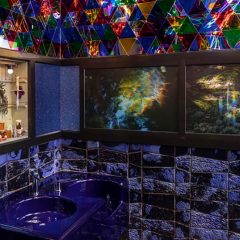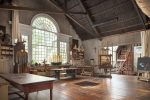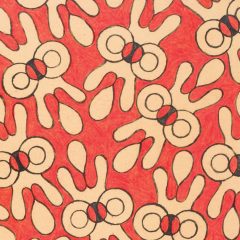As I was leaving the Metropolitan Museum of Art (MMA, or The Met) on a Sunday afternoon in July, I followed the line of people waiting to get into the Alexander McQueen exhibition. The line ran the entire length of the corridor of the 19th century galleries, took a left turn where it continued through the enfilade of Near Eastern galleries and ended somewhere on the mezzanine balcony. It was 3:45, and I doubted everyone would get inside the exhibition, much less have time to see it properly. Now, the McQueen exhibition was spectacular – literally and figuratively – but there’s an awful lot of extraordinary art in the Met that’s overlooked – and for no reason. I suspect that if much of it were packaged as Splendors of the Medieval Collection, or Wonders of the South Pacific, they too would draw crowds. Which inspired me to start an occasional series titled One Work Worth the Trip; I think the name explains itself. So, for an overlooked wonder at the Met I suggest this small but powerful earth mother:
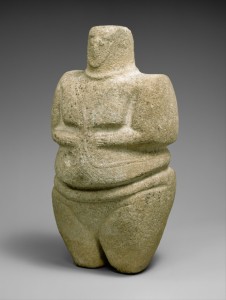
I admit that until now, I too, had overlooked this Bronze Age beauty from the land of frankincense and myrrh (modern Yemen and Oman), dressed in something less than a bikini. This five thousand year old statue speaks of the essential role of fertility, and if she wasn’t used to invoke human fertility (those hips are certainly built for childbirth), she speaks of the association of female fertility with that of crops. Based on her weight, this figure would likely have been made to stand in a specific place, unlike the similarly-buxomVenus of Willendorf (now dated to 30,000-25,000 B.C.) in the Naturhistorisches Museum, Vienna, which at 11 cm, fits perfectly in the palm of a hand.
We may never know much about this figure’s function or meaning; objects from pre-literate cultures are largely questions without answers. Still, this small and restrained figure retains great power, even after five millenia. Viewers who admire Brancusi’s Kiss will be taken with the abstracted forms of her body that still clearly retain the initial shape of the stone; how much the carver did with so little.
Definitely worth the trip.
I was trying to figure out how to direct viewers to the figure. The Met’s rooms are numbered on the museum’s map, but if there were numbers in the galleries, they escaped me. Then I realized that the room was adjacent to the gallery that leads to the great reliefs from Nimrud. I thought, how could I pass them over? I couldn’t. Flexibility is a virtue, so the initial One Work Worth the Trip includes two.
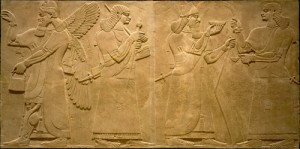
Ashurnasirpal II (r. 883–859 B.C.) was one of the dynasty of Assyrian kings who ruled the Middle East from territory centered in Northern Iraq. Above are two from a gallery at the MMA entirely surrounded by reliefs from the palace Ashurnasirpal II built at his new capital at Nimrud (which had been an outpost until his building campaign). The king is second from the right, performing a ritual with his attendants. Texts running across the figures describe the palace in the first person of the king, with comments such as: Beasts of the mountains and the seas, which I had fashioned out of white limestone and alabaster, I had set up in its gates. I made the palace fittingly imposing. The human-headed bull, below, and his double would have guarded a palace door.
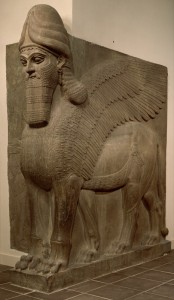
The British Museum also has reliefs and guardian figures from Ashurnasirpal’s palace, and from those of later Assyrian kings. The museum’s website is a great resource for background information on Assyrian history, culture, and artifacts; part of the site is billed as The ultimate guide to the Ancient Near East on the Internet. I have no way of testing that claim.
The reliefs in London attract a lot of attention, so it’s a mystery to me that those in New York are ignored. I spoke with a guard about it (he was an illustrator himself, and paid attention); he said no one spent much time looking at the reliefs, but people did use them as a site for taking photographs. Art as photo op will be the subject of a later post.
If the visual expression of power is of interest, I think the Assyrians beat anything done by the Egyptians. They fully understood the political significance of imagery. I find that these reliefs invoke the aspirations of real absolute rulers – their accomplishments, violence, self-promotion and tyranny. Which can’t help reminding me of Shelley’s great meditation on such images of power, Ozymandias:
I met a traveller from an antique land
Who said: “Two vast and trunkless legs of stone
Stand in the desert. Near them on the sand,
Half sunk, a shattered visage lies, whose frown
And wrinkled lip and sneer of cold command
Tell that its sculptor well those passions read
Which yet survive, stamped on these lifeless things,
The hand that mocked them and the heart that fed.
And on the pedestal these words appear:
`My name is Ozymandias, King of Kings:
Look on my works, ye mighty, and despair!’
Nothing beside remains. Round the decay
Of that colossal wreck, boundless and bare,
The lone and level sands stretch far away”.



